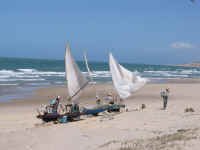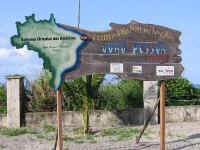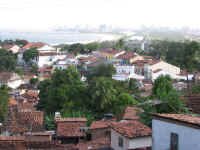August 25 - 26, 2005
Arriving in Fortaleza, our main priority is finding a propane/butane yard that can fill our tank of cooking gas. Although we could probably get by for a couple of more weeks, we'd like to know that we won't accidentally run out some night. We've been looking for a fill for the last few days but have only been able to find locations that rent already filled tanks but which are unable to fill our tank. The gas company people in Teresina were nice enough to give us the address of the butane yard here and told us that they would be able to help us.
Our guide book has very basic maps of cities, mostly designed to assist travelers who arrive by bus and who stay primarily in the center of the city. So when we arrive by truck, we find that the maps don't really show us how to navigate the whole city. Today we decide to find a taxi driver that we can hire to lead us to the butane yard. After driving almost into the center of town, we find a park where the taxis wait for calls. Also around the park are a group of motorcycles known as moto-taxis. Yes, here in Brazil you can hire a motorcycle to take you where you need to go, just jump on the back of the seat. We have seen them mostly in small towns, but since they are here we decide to try hiring one to be our guide.
One driver was willing to guide us and we set off following him here and there around the city streets. Although he has eyes for all the pretty girls on the sidewalks, he is a good leader and makes sure that we are never more than a bus length apart. After about 20 minutes we cross over the railroad tracks into the port area of the city and ... there it is, the butane yard! Oh man, we just about can't believe it, it was almost too easy. We pay our driver and give him a good tip - he was also excited about finding the right place too. It takes only about an hour and we get our tank filled and we get back on our way.
We're heading down the coast to a small town that is known for their pink sand dunes. Canoa Quebrada turns out to be a quaint little village right on the coast and the village is built all along a massive sand dune. We drive over blowing sand to reach the main street, then as we get down to the water, we find a row of restaurants built at the base of the dune just above the high tide line. All along the sand are small Jangadas, literally rafts, that the local fishermen use to sail up and down the coast in search of fish. These rafts are so small that they only hold two people, and they have to stand as the water flows over the base of the raft when they are at sail! This is really a hard way to make a living.
We find a nice spot along the beach to camp later, but tonight we want to have dinner in town to celebrate Kim's birthday. After a great seafood dinner we go back to our camping spot only to find that the wind has picked us so much that it rocks the Fuso like a boat at sea. So we give up on the idea of beach camping tonight and drive back towards town and make camp at a restaurant at the base of the dunes.
| In the morning we walk along the beach checking out the restaurants as the workers prepare for the day by putting tables and chairs onto the sand for use by their customers. The idea is that beachgoers will decide to stay at their tables to enjoy the beach, while purchasing food and drink from the restaurant. We also watch the fishermen come back with their meager catches and watch as they work using coconut tree trunks as rollers under their rafts to push them over the sand out of reach of the high tide. |
We just hang out at the beach for a relaxing day, then as the winds gain in intensity again in the evening we move into town to spend the night.
August 27, 2005
Nearly every driving day puts us into a new Brazilian State. Today our drive took us across the end of the northern facing coastline of the country and to the east coast. From here it will be all down hill, actually all southerly until we get to Rio.
All along the roads we always see people who have set up little stalls, nothing more than four poles with a thatched roof, where they sell all sorts of things. Today we decided to stop to see what was available, and found that they were selling bags of freshly roasted cashew nuts. This isn't surprising as we have seen farms full of cashew trees for the last couple of days. We buy a big bag for just 5 reals, about $2.20 - and oh they are so good.
Tonight we were looking for our first Brazilian campground. We found a good website, Webcamping Brazil, that lists campgrounds all around the country. Surprisingly we actually found it even though our maps didn't show the road that it was located on. It was a really nice spot with a fishing pond, three swimming pools, a restaurant and room for dozens of campers, and tents. Being a Friday night, the campground was empty except for us as most Brazilians work 6 days a week. This campground was south of Natal in the town Pathamirim.
August 28, 2005
After a relaxing morning in the campground pool, we headed off toward the most eastern part of the Americas, Praia do Seixas. This beach is extremely popular with people who live in the town just north of it, Joao Pessoa. On the weekends, the beaches and restaurants fill up with beachgoers who eat, drink, play and party till all hours of the night.
| Driving along the beach road, it was crowded and when we reached the lighthouse that marks the easternmost spot, cars were parked on both sides of the road, making the driving difficult. Finally negotiating through, we found a spot to park and check out the spot in Brazil that is actually closer to the Senegalese coast of Africa than it is to the southern coast of Brazil! After contemplating that amazing fact, we headed off to our second Brazilian campground. |
At the campground, we finally got to meet some Brazilian motorhome owners. One couple greeted us with a pot of beans and rice and offered us four of the coconuts they had. Accepting with a smile, we attempted a conversation about our motorhomes and lives. Even though the conversation was difficult, we learned that the wife is a lawyer, they live in Joao Pessoa and use their motorhome to get away on weekends, just as many Americans do.
August 29
After a brief rainstorm in the morning, we headed into Joao Pessoa in search of a front end alignment for the Fuso. The roads had done a number on our tires and we noticed that our front tires were wearing unevenly. Our first stop at a Mercedes Benz/Michelin dealer didn't work out and they sent us in search of another place across town. We couldn't find the one they sent us to, but we stopped at a Bosch shop. They couldn't do the alignment either, but they told us that there are Bosch shops all over the country and they would be able to do the service we need to get done before we leave the country. They even gave us a map showing all their shops. That will come in handy later.
Back on the highway, we finally found a Goodyear dealer with a shop that was willing to do the alignment. They attached a couple of "torture devices" to the wheels and discovered that our alignment was actually fine, it was our tie rod that needed adjustment. And apparently it was way off. But fix it they did, at a very reasonable cost too (less than $15.00US).
Back on the road, we headed south to the Colonial town of Olinda, just outside of Recife. Olinda is one of the largest and best-preserved colonial towns in Brazil and is considered the cultural center of Recife. When sugar cane was introduced to Brazil, the state of Pernambuco quickly became one of the most important production areas in the country. Much wealth was accumulated and plantation owners built their homes on the hills that were to become the city of Olinda. Most of the buildings were built in the 16th century and many have been reconstructed.
After a few wrong turns, we finally found our way into the center of the city and found a spot to park. We wandered around up and down the hills looking at the old buildings and enjoying the fantastic view over Recife and the ocean.
Leaving Olinda, we drove a short distance down the road to the Recife Convention Center, when the parking attendants allowed us to park the Fuso for the night. The night watchman was very diligent and took turns walking around the center and guarding over us like a hawk.


